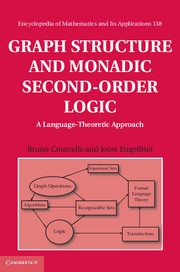Book contents
- Frontmatter
- Contents
- Foreword
- Introduction
- 1 Overview
- 2 Graph algebras and widths of graphs
- 3 Equational and recognizable sets in many-sorted algebras
- 4 Equational and recognizable sets of graphs
- 5 Monadic second-order logic
- 6 Algorithmic applications
- 7 Monadic second-order transductions
- 8 Transductions of terms and words
- 9 Relational structures
- Conclusion and open problems
- References
- Index of notation
- Index
2 - Graph algebras and widths of graphs
Published online by Cambridge University Press: 05 July 2012
- Frontmatter
- Contents
- Foreword
- Introduction
- 1 Overview
- 2 Graph algebras and widths of graphs
- 3 Equational and recognizable sets in many-sorted algebras
- 4 Equational and recognizable sets of graphs
- 5 Monadic second-order logic
- 6 Algorithmic applications
- 7 Monadic second-order transductions
- 8 Transductions of terms and words
- 9 Relational structures
- Conclusion and open problems
- References
- Index of notation
- Index
Summary
We will define graph operations that generalize the concatenation of words. Some of these operations have been used in Section 1.1 to define the cographs and the series-parallel graphs. We will define actually two signatures of graph operations, hence two graph algebras. Both algebras will be defined in such a way that their equational sets are exactly the sets defined by certain context-free graph grammars. (The notion of an equational set has been presented informally in Section 1.1.4 and will be studied in detail in Chapter 3.)
Two main types of context-free sets of graphs defined by certain graph rewriting mechanisms have emerged from the intense research conducted from around 1980 and synthesized in the handbook [*Roz] edited by Rozenberg.
We will first define the HR graph algebra that corresponds in this respect to the hyperedge replacement grammars. It turns out that the operations of this algebra yield an exact characterization (as equational sets) of the sets of graphs of tree-width bounded by fixed integers. The terms built with the operations of the HR algebra can be seen as algebraic expressions of tree-decompositions. (Tree-width and the corresponding tree-decompositions are important for the construction of efficient graph algorithms and also for the characterization of the graphs that exclude a fixed graph as a minor.)
The second algebra, called the VR algebra, is defined so that its equational sets are those generated by the (context-free) vertex replacement grammars. A new graph complexity measure called clique-width has arisen in a natural way from the definition of the VR algebra, without having (yet) any independent combinatorial characterization.
- Type
- Chapter
- Information
- Graph Structure and Monadic Second-Order LogicA Language-Theoretic Approach, pp. 80 - 187Publisher: Cambridge University PressPrint publication year: 2012

